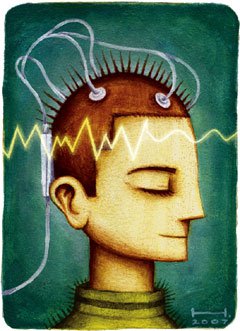Doctor Electric: A Handy Electromagnetic Gadget Stimulates the Brain
Feeling foggy? Take 2 milliamps to the brain
and call me in the morning.
Your content has been saved!
Go to My Saved Content.
Imagine you have aheadache. Oryou're too fried to face a busyworkload. Rather than takingaspirin or coffee, you put a smalldevice the size of an iPod to the back ofyour head and push a button to revitalizeyour brain. Sound futuristic? It maynot be many years away.
Scientists have scrutinized thehuman brain for thousands of years,but with the use of electricity and magnets,medical researchers are gettingcloser to identifying the areas -- andcreating the tools -- that stimulate andrepair the mysterious organ.
Eric Wassermann, a neurologistand chief of the Brain StimulationUnit at the National Institute ofNeurological Disorders and Stroke (NINDS), has comeclosest to creating an inexpensive,painless "thinking cap." The deviceruns on electrical currents, known astranscranial direct current stimulation.His studies have shown that tDCS canboost verbal skills in healthy peopleby as much as 20 percent.
In one study, volunteers were askedto recall and say as many words thatbegin with a particular letter as possible,then passed a tiny (2-milliamp) current through electrodesattached to their foreheads. The volunteers were quizzed again using adifferent letter with the current on and were able to come up with20 percent more words. The only side effect so far has been itching ortingling on the scalp.
Wassermann can't pinpoint exactly what is happening, but hethinks tDCS lets the prefrontal cortex, the brain part associated withverbal memory, transmit signals more easily. Any function associatedwith a specific regionof the cerebral cortex(the outer edges of thebrain) is potentiallywithin tDCS's reach. The goal is to make the targeted area work moreeffectively, like giving it a small cup of coffee.
"It doesn't cause neurons to fire on their own -- it needs to have somedrive on them to do so," says Wassermann. "It's a little like treatingspecific nerve cells locally with a drug, so it could be a very helpful wayof boosting brain function in people with brain disorders and injuries."
Even though he is focusing on tDCS for more heavy-duty problemslike head injuries and dementia, Wassermann does not rule out a thinkingcap that any healthy person could use to boost brainpower with theflick of a switch. The device is alreadysimple and easy to make, he says."Anyone with the know-how could goto an electronics store, buy the components,and build one. It's simply a 9-voltbattery, a couple of wires, and somepieces of wet sponge. The question nowis, what part of the brain do you stimulate,and how can it actually help you?That's what we're still trying to learn."
Neurologists are also using electricityto try to treat various brain disorders,from Parkinson's disease to headaches.As early as 45 BC, a Roman court physiciannamed Scribonius Largus notedthat the application of live torpedo fish,a type of electric ray, to patients' foreheadscured headaches. Greek physicianand philosopher Galen noted the samefindings a century later.
The modernversion of Largus's and Galen's fishinvolves magnetic pulses in an up-and-comingtreatment known as transcranialmagnetic stimulation. Techniquesare still being refined, but researchersknow that by placing a TMS device ondifferent areas of the head, they canmake fingers twitch or freeze speech inmid-sentence. Doctors treating depressionaim the magnets at the prefrontal cortex, while those treatingmigraine headaches go toward the nerve centers in the back of the head.
"There's evidence that migraines start with electrical hyperexcitabilityin the brain's cortex," says Yousef Mohammad, a neurologistat the Ohio State University Medical Center, who has found evidencethat a TMS device placed against the back of the head can preventmigraine pain. "Our theory is that if we can break that with two pulsesof an electromagnetic field, we can abort a headache before it starts."Mohammad is workingwith a medical companyto research a portableTMS device the size of ahair dryer, and recently launched a bigger study nationwide.
Wassermann has also tested TMS by using himself as a guinea pig.He had a fellow researcher target his brain's speech centers by zappinghim while speaking, which stopped him in mid-sentence -- a feelinghe calls "indescribable."
So next time you feel frazzled or foggy, think of strapping on acatchy-looking gadget and gently jolting your way to rejuvenation.Now, that's an electrifying thought.